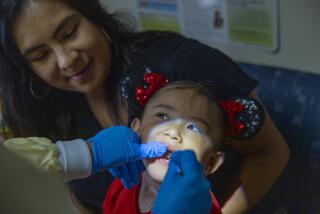Visitors Say ‘Ah’ to Dental Museum in Baltimore : History: Displays will promote conscientious oral hygiene and regular care, and recap advances.
- Share via
BALTIMORE — Faster than you can say “nex-x-x-t,” Dr. Ben Swanson Jr. opens a drawer, extracts a clear plastic box and presents what will be the crowning glory of a museum dedicated to pearly whites and those who care for them.
The contents of the box don’t look like much--a fragile semicircle of hand-carved ivory held together with wire. But this lower denture, a rather uncomfortable-looking one at that, once sat on the gums of George Washington.
A few blocks from a museum devoted to horror writer Edgar Allan Poe, the Dr. Samuel D. Harris National Museum of Dentistry will extol a profession that exemplifies the maxim “no pain, no gain.”
The museum, scheduled to open in 1996, will promote the benefits of conscientious oral hygiene and regular professional care, and recap advances in dentistry, such as the invention of the high-speed dental drill.
An advancement, you say?
Well, yes, said Swanson, when compared to the agonizing pace of slow-speed drills.
“It’s just so smooth and fast,” said Swanson, the museum’s director and--you guessed it--a dentist himself. “Patient comfort has been improved tremendously.”
For many people, a trip to the dentist is not quality time. Even the museum’s very own tooth fairy, retired 91-year-old Detroit dentist Dr. Samuel D. Harris, remembers his first visit as being none too pleasant.
Harris, who donated $1 million to the museum, judged himself to be independent enough to go to the dentist by himself at age 8.
“I had a lot of trouble with a tooth, and I wasn’t going to tell my parents about it,” Harris said. “He did take out the tooth--a molar.”
Ouch.
Harris, who also is a founder of the American Society of Dentistry for Children, wants his namesake institution to emphasize education, prevention and early care.
Children may find incentive to brush once they’ve seen some of the museum’s exhibits.
The “key,” for example, introduced in roughly the 1730s, was used for extractions. Its hinged “claw” clasped the tooth, which was pulled by turning the instrument like a key.
“There’s a lot of torque in this, and really it was a very quick way to perform extractions at a time when they didn’t have painkillers,” said Swanson, who has a master’s degree in dental history.
Although practiced since the age of the pharaohs, dentistry didn’t become an organized profession until recent times. The world’s first dental school, the Baltimore College of Dental Surgery, was established in 1840. Before that, dentists trained through apprenticeships. In the Middle Ages, dentistry was performed by barbers.
The American Dental Assn. is supporting Baltimore’s dental museum as the official museum of the profession, but there’s one big question mark:
Will people who don’t want to go to the dentist go to a museum about them?
“I think people will be really fascinated by the notion that we’re going to talk about pain and how bad it could be,” said Richard Molinaroli of the Washington firm of Miles Fridberg Molinaroli Inc., which will design the exhibits.
About 40,000 artifacts will be displayed at the museum, located on the University of Maryland at Baltimore campus.
The museum also may pay homage to the more dashing and inventive among the profession.
John (Doc) Holliday was a dentist, as was author Zane Gray, said curator Dr. John M. Hyson Jr., a modern-day colleague. In 1844, a Connecticut dentist was the first to realize the anesthetic qualities of nitrous oxide, until then a novelty because it made people laugh.
More to Read
Sign up for The Wild
We’ll help you find the best places to hike, bike and run, as well as the perfect silent spots for meditation and yoga.
You may occasionally receive promotional content from the Los Angeles Times.





